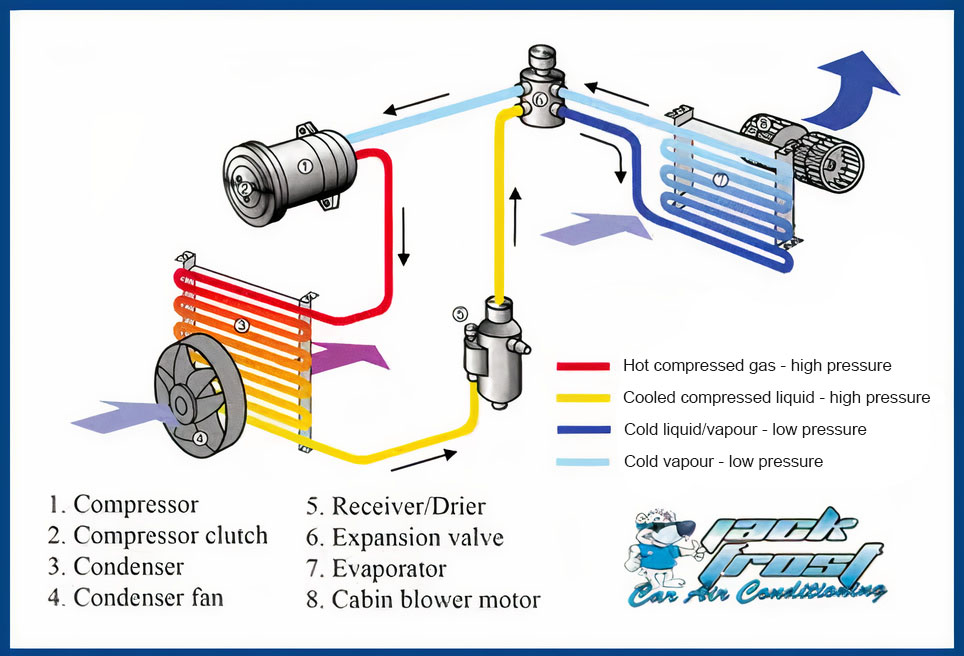Air Conditioning Works On One Side Of Car

Experiencing uneven cooling in your car's air conditioning system? It's a frustrating issue, particularly when one side blows ice-cold air while the other provides only lukewarm relief. This isn't just an inconvenience; it often indicates a problem within the A/C system that needs immediate attention to prevent further damage and ensure passenger comfort. Let's delve into the common causes of this frustrating phenomenon and how to diagnose and address them.
Understanding the HVAC System
Before we get into the specifics, let's briefly recap the basics of a car's Heating, Ventilation, and Air Conditioning (HVAC) system. This system is responsible for controlling the temperature, airflow, and air quality inside the cabin. Coolant from the engine helps heat the air while the A/C system works to cool it. The entire system relies on a network of ducts, vents, actuators, and blend doors to precisely deliver air at the desired temperature and location.
Common Causes of Uneven Cooling
Several factors can contribute to an A/C system blowing cold air on one side and warm air on the other. The most frequent culprits include:
- Blend Door Actuator Malfunction: This is arguably the most common cause. Blend doors are small flaps within the HVAC system that control the mix of hot and cold air entering the cabin. These doors are operated by electric motors called blend door actuators. If an actuator fails or becomes stuck, the blend door may remain partially open or closed, leading to uneven temperature distribution. A failing actuator will likely trigger a diagnostic trouble code (DTC) that can be read with an OBD-II scanner. Symptoms include clicking noises behind the dashboard or a complete lack of temperature control.
- Refrigerant Issues: Although less likely to cause side-specific cooling issues, extremely low refrigerant levels can sometimes contribute. Refrigerant is the lifeblood of the A/C system, responsible for absorbing and releasing heat. A leak in the system, even a small one, can cause the refrigerant to deplete over time. This might manifest as weak cooling performance overall, but if the system is critically low, one side might suffer more than the other due to the physical layout of the evaporator core and ductwork. Look for signs of leaks, such as oily residue around A/C components.
- Clogged Evaporator Core: The evaporator core is essentially a radiator for the cold refrigerant. As air passes through it, the refrigerant absorbs heat, cooling the air before it enters the cabin. If the evaporator core becomes clogged with debris (leaves, dust, etc.), airflow can be restricted, leading to reduced cooling performance. In severe cases, this can affect one side of the system more than the other, depending on the location of the blockage.
- Ductwork Problems: Damaged or disconnected ductwork can also cause uneven cooling. If a duct leading to one side of the cabin is damaged or has become detached, the cooled air will escape before reaching the vents. This is more common in older vehicles where the ductwork can become brittle and prone to cracking.
- Zone Control Issues: Vehicles equipped with dual-zone or multi-zone climate control have separate blend doors and actuators for each zone. A problem with the control module or the wiring to a specific zone's actuator can prevent it from functioning correctly. Scan tool diagnostics are essential for pinpointing these issues.
Diagnosis and Repair
Diagnosing uneven cooling requires a systematic approach. Here’s a step-by-step guide:
- Initial Inspection: Start by visually inspecting the A/C system components for any obvious damage or leaks. Check the compressor, condenser, and refrigerant lines.
- OBD-II Scan: Use an OBD-II scanner to check for any diagnostic trouble codes (DTCs) related to the HVAC system. This can provide valuable clues about the source of the problem, especially regarding blend door actuators.
- Blend Door Actuator Testing: If a blend door actuator DTC is present, test the actuator's functionality using a multimeter or a scan tool. You can also manually move the blend door to see if it's stuck or binding. In many cases, replacing the faulty actuator is the solution.
- Refrigerant Level Check: Use a manifold gauge set to check the refrigerant pressure in the system. If the pressure is low, locate and repair any leaks before recharging the system. Note: Refrigerant handling requires proper certification and equipment.
- Evaporator Core Inspection: While more involved, inspecting the evaporator core can reveal any clogging or damage. This often requires removing the dashboard and HVAC housing.
- Ductwork Assessment: Examine the ductwork for any cracks, leaks, or disconnections. Repair or replace any damaged sections.
Real-World Example
Consider a 2015 Honda Accord experiencing this issue. After hooking up an OBD-II scanner, a code related to the passenger-side blend door actuator was retrieved. Further testing confirmed the actuator was faulty. Replacing the actuator resolved the problem, restoring consistent cooling to both sides of the vehicle. This illustrates the importance of starting with a diagnostic scan.
Preventive Maintenance
Regular maintenance can help prevent uneven cooling and other A/C system problems. This includes:
- Regularly checking and topping off refrigerant levels.
- Replacing the cabin air filter to ensure proper airflow.
- Having the A/C system inspected by a qualified technician annually.
By understanding the potential causes of uneven A/C cooling and following a systematic diagnostic process, you can effectively troubleshoot and repair this common automotive issue, ensuring a comfortable driving experience for everyone in the car.
